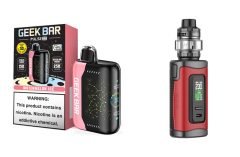Table of Contents [show]
Spinfuel Guide To Vaping – Batteries for your Advanced Personal Vaporizer (APV)
Introduction
Battery technology has become increasingly sophisticated in recent years. Advancements are coming fast and furiously, especially in the computer industry and in laptop and mobile devices. In this, and other articles produced by Spinfuel eMagazine, we barely scratch the surface when it comes to many of these advanced technologies you, and we, use every day. We prefer to present that information in the simplest terms possible, while maintaining the accuracy of that information in everyday language.
For that reason we ask that you read these articles with the understanding that the focus is limited, and there is more to know, and more to learn, if you so desire. We will often be redundant while writing them, the idea being that if you’re trying to get the point across the best way to do that is to say it over and over, in slightly different ways. You can also take a look at our Battery Chart.
Our focus today is on one certain aspect of battery technology, and how that aspect plays a part in the overall satisfaction of the average Vaper. Please do not rely on any of our articles on batteries as expert level papers. We are not engineers, we are Vapers, like you, who might have more experience with vaping, but who are limited in the science of battery technology.
Introduction
In the previous Spinfuel’s Guide to Vaping article called ‘Understanding MilliAmp Hours’ John Castle offered a solid elementary foundation for understanding how ‘mAh’ works. In this article I’ll cover the fundamental reasons why you should understand what ‘mAh’ means and what it means to your battery purchases. Before I move on to the APV, let’s touch on cig-a-likes for just a moment.
Cig-a-likes
If you are a Vaper that loves to use the cig-a-like batteries, for instance, understanding the differences in ‘mAh’ for batteries offered by Brand A and Brand B, you can make a better decision on which brand will provide you the best bang for your buck.
If you have some experience with cig-a-like batteries from Blu Cigs and Halo Cigs, the reason why Blu Cigs premium batteries are so frustrating is because the mAh rating is so low, roughly 85-90mAh, they don’t last very long. Whereas Halo Cigs uses a cig-a-like battery that is rated much higher in mAh, 320mAh to be exact, allowing you to vape much longer before having to recharge them. Blu Cigs Premium100 batteries are rated at 226mAh, still far below Halo but they do last longer than their blu premium counterparts.
None of this means that mAh ratings are the singular indicator that should be looked at when deciding which cig-a-like will work best for you. There are other factors at play, from the voltage they put out to the ohms of their prefilled cartomizers, and especially the type of threading they use for their cartomizers.
The APV
However, if you are using an Advanced Personal Vaporizer, or APV for short, then your battery situation is somewhat different.
Let’s say you’ve advanced your vaping experiences from the cig-a-like batteries and have moved on to more powerful devices. These APV’s offer features you’ll never find in stick batteries (cig-a-likes), such as variable voltage, variable wattage, power indicators, ohm readings, and more.
While presenting you with more features over cig-a-like batteries the APV gives you the power to fine-tune your ‘vape’ so that you are making the decisions on how warm your vapor is, how much is being produced, and basically dialing in just the right amount of flavor from the eLiquid.
Once you understand how these features work in conjunction with each other you begin realizing the wonderful results and you are well on your way to becoming an advanced Vaper. But there is still one thing you might not have had to deal with; that ‘thing’ being the mAh rating of the batteries you buy.
Word of Caution: This is a discussion on batteries being used in devices made for vaping. Always use extra caution when working with Li-ion batteries because they are very sensitive to charging characteristics. Mishandling batteries, or charging them in poor quality chargers, or over-charging them may cause them to explode or catch fire.
Make sure you have enough knowledge of these rechargeable batteries before you begin using them. Always charge your batteries on a fireproof surface, and always use a properly working charger. I use a LUC 4-bay charger from MyVaporStore that I swear by, our own John Castle recommends the Nitecore Intellicharger i2 and i4, and others have used TrustFire or others with good results. But always make sure the charger is in good working order.
To reiterate: Do Not leave batteries unattended during charging. Do not charge batteries during a time when you cannot divert your attention such as while driving. Your safety and the safety of your loved ones is paramount.
Now, where was I?
18650 – 18350 – 18500, et al…
The vast majority of reviews you read, or videos you watch, or even the product pages on your favorite vendors website, will tell you what ‘size’ batteries you will need to purchase for the device you’re reading about, and whether or not those batteries sizes require a flat-top or button top, but that’s about it. No one ever really gets into the mAh ratings of batteries.
For every device you’ll see the following in some form or another:
- “The JoyeTech eVic takes a flat-top 18650 battery”
- “The ProVape ProVari takes a button-top 18650 battery”
- “The Innokin iTaste Cool Fire 2 takes a flat-top 18350 battery”
- “The VAMO Rev 5 takes a flat-top or button-top 18650 battery”
And so on…
That’s all well and good; you need that information. Especially the bit about whether or not that particular battery is a flattop or button-top. But where is the explanation for mAh? Should there even be an explanation for the mAh rating? Perhaps not on the product page or in the review or even in the videos, but you do need to know in order to best utilize the money you’re going to spend on the device.
Choices and more choices…
To illustrate this point take a look at the Innokin iTaste SVD on MyVaporStore:
I chose this device because it is one of the few devices that can handle just about any 18000-series battery you want to use, including both the flat-top and button-top variety. In addition, as you can see by the list of batteries offered for sale on the product page for the SVD, it lists eight (8) different batteries, from an 18350-800mAh flat or button top, all the way up to the 18650-3400mAh batteries. All these choices, which one is right for you?
Buying The Battery
Looking again at the list of compatible batteries for the iTaste SVD you’ll notice that the price for a 2-pack of batteries (always buy new batteries in twin-packs, you’ll need a spare) range from $11.85 for a twin-pack of 800-mAh 18350’s all the way up to $31.69 for the 3400mAh Panasonic 18650. The iTaste SVD is priced at $99.95, now add sales tax and shipping and it can be as high as $115 or so before you add the battery.
If you don’t know what the mAh rating means, and more importantly, what it means to you and the device you’re going to purchase, how do you know which battery to place in the shopping cart? Do you choose the least expensive battery to save money?
Before you answer that, consider your personal vaping habits. Do you vape only once in a while during the day, or are you a Pacify-Vaper, with your hardware always topped off with eJuice and never leaving your hand? How often are you swapping out batteries?
In absolute layman’s terms in Spinfuel’s Guide To Vaping article John told you how the mAh rating is, at its most basic, an indicator on how long you will go between charges. The 800mAh 18350, the smallest battery and the lowest mAh rating will need to be recharged much more often than the Panasonic 3400mAh 18650. Where does your needs fit in? Do you want to go two days without the need to swap out a battery or is it okay to vape for 8-10 hours without swapping the battery? In a nutshell, that is the only question you need to ask yourself before choosing the compatible battery.
If you’re wondering if the mAh rating on the battery serves any other purpose, rest assured that it does not.
The mAh rating has one function, and one function only. The mAh rating gives you an idea of how long that battery will last while you are using it. That’s it. A higher mAh rating will not have any affect on the quality of your ‘vape’. It will not help produce more vapor, it will not add flavor to your eLiquid. These are all controlled by other factors, including the ohms that the atomizer outputs and the voltage regulator of the device itself, not the mAh rating.
The mAh rating will not increase or decrease the quality of your vaping experience in any other way than the length of time you’ll use that battery before having to recharge it.
I have seen many people opt for a more expensive battery thinking that if they buy the 2200mAh battery instead of the 1100mAh battery the device will work better, or the vape experience will ‘be’ better. 2200 is larger than 1100, so larger must be better, right? In this case ‘no’. Again, the number simply means the length of time you will vape with that battery before having to recharge it.
Case in Point
At the beginning of 2013 JoyeTech released their eVic APV. Much was written about the eVic, and several videos were made, including by own SmokenJoey. The eVic was, and remains, a very advanced APV. A friend of mine who had been a heavy smoker for some 30+ years, and he read our review for the eVic and decided that if he was ever going to quit smoking and switch to vaping the eVic was the best tool for the job. As it turns out he was right, he hasn’t smoked a single analog since buying the eVic, but that’s beside the point.
When his eVic kit arrived it contained a 2200mAh battery. About a month later the green colored 3400mAh battery was released for the eVic and my friend insisted that he had to buy a couple of them.
I remember asking him at the time why he wanted to switch to 3400mAh and he told me that the eVic “had to work even better with a 3400mAh battery”. To make a long story short, he didn’t understand the mAh rating simply meant the amount of power stored in the battery, he believed that the 3400mAh would provide more power to the eVic, not the ‘same power over a longer period of time’. After I explained it to him he bought them anyway, but now he understood that he was laying out the $35 in order to go on vaping longer between charges, and that the variable voltage and wattage would remain working in the same way as before.
Conclusion
To recap: The mAh rating does matter, but only in the length of time you can use that battery before having to recharge it. It will not improve your vape experience one iota, except in the aforementioned manner. Once you understand that you can begin making better decisions about which battery is right for you by thinking in terms of your own vaping style and whether or not you’re spending too much time attaching batteries to chargers. As long as the battery you are buying is compatible with the device you’re using the mAh rating will not affect its operation in any other manner.
There is nothing wrong with wanting to buy the highest mAh rated batteries you can find that are compatible with the device you’re using. As I began replacing batteries for my devices that use 18650 batteries I have made it a point to buy the higher mAh rated batteries for the added number of hours I can enjoy my device before having to switch out that battery. If your budget only allows 1100mAh batteries you’re getting the same quality from your device that I am, you’re just recharging them more often than I do.
Last Word
We do not want to leave you with the impression that all batteries are alike. They are not. Like anything else, quality matters. Some battery companies make cheap, poorly built batteries that carry the same specs as high quality, well made batteries. Sony, Samsung, Panasonic, and Efest are names we have come to trust when it comes to quality batteries, and all of these are available at most vendors. Battery Chart at Spinfuel
If you’re enjoying your APV but you’re not happy with the length of time you can vape before having to swap out your battery it may be time to move up to a higher mAh rating.
And that is it. Simple, right?




